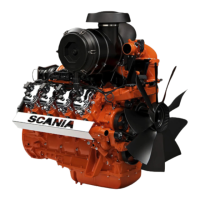INSTALLATION
MANUAL
© Scania CV AB 2018, Sweden
Batteries and alternators
03:01 Issue 11 en-GB 5
At low temperatures, the battery capacity is reduced considerably as shown in the fol-
lowing table:
The cold cranking amperage above indicates the highest current with which a 12 V
battery can be loaded at -18°C so that the terminal voltage after 30 seconds is a min-
imum of 8.4 V and the discharge time to 6 V is no less than 120 seconds.
If the engine is fitted with an alternator, the battery master switch must not be
switched off or the batteries disconnected when the engine is running. Voltage peaks
can damage components in the alternator and the charge regulator.
The batteries in stand-by generator sets must be checked for their state of charge and
fluid level and charged if required. Batteries may be charged either during the normal
test drive (once a month) for approx. 1 hour or using a battery charger and timer.
Boost charge and continuous trickle charge shorten the service life of the batteries.
Battery capacity at +20 °C Battery capacity at -18°C
100% 50%
70% 35%
40% 25%
Connection of batteries
Connect the battery cables correctly, i.e. negative (-) to the engine ground point and
positive (+) to the starter motor terminal screw 30.
The alternator rectifier diodes will be damaged if these cables are connected incor-
rectly.
Do not disconnect the connections while the engine is running, as this may damage
the charge regulator.
• Removing: Always disconnect the negative cable before the positive cable.
• Fitting: Always connect the positive cable before the negative cable to reduce the
risk of short-circuiting the battery with the tool.
• Make sure that the battery box, batteries and battery cable terminals are clean.
• Do not bang the battery cable terminals. Terminal posts and cell plates come off
easily.
• Lubricate battery cable terminals and terminal posts using a thin layer of Vaseline
or grease.

